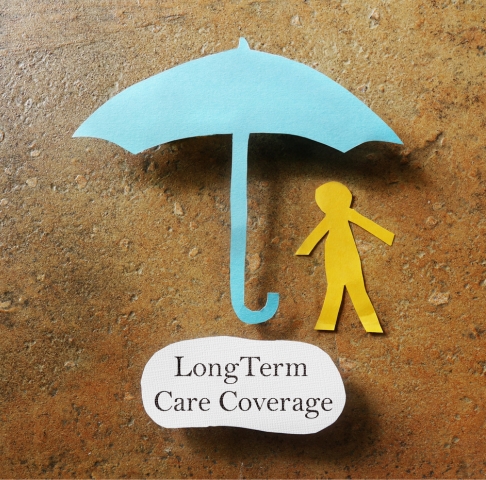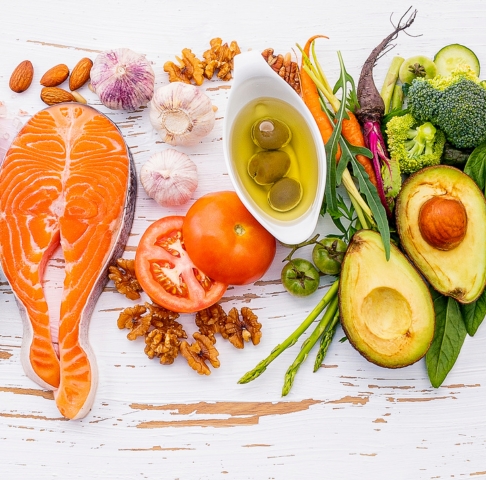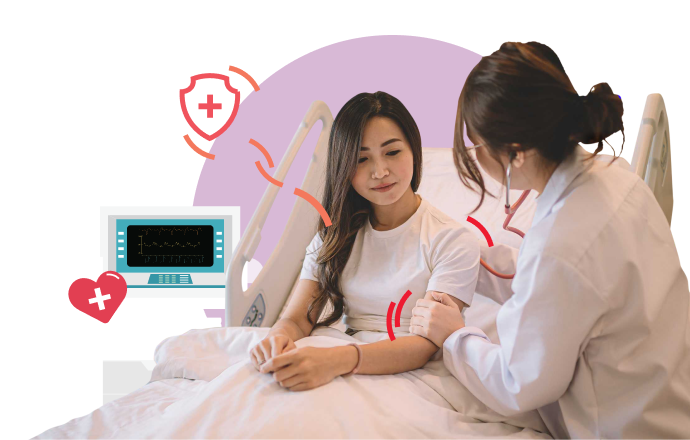My go-to drink tells me I’m a C. If I pick something less “risky”, I’m a B, and if I go with full-on indulgence, I'm a D. Before you throw wild guesses about what these letters mean, let me establish that I’m talking about non-alcoholic beverages and their Nutri-Grade labels. The traffic-light looking mark on pre-packaged drinks was introduced on 30 December 2022, with grade D (red) beverages having the highest sugar and/or saturated fat content and grade A (green) beverages having the least. Whenever I reach for a C or D, I put myself at greater risk of obesity and diabetes.
Singaporeans are drinking their way to diabetes
Pre-packaged drinks are the primary culprits for Singaporeans’ excessive sugar and fat intake, which is linked to obesity and diabetes. We consume an average of 12 teaspoons of sugar daily, and more than 50% of this comes from beverages, predominantly pre-packaged beverages.1 These include things like sodas and three-in-one instant drinks.
Twelve teaspoons exceeds the World Health Organization’s guidelines i.e. to keep sugar intake to under 10% of your daily energy needs, which works out to less than 10 teaspoons for the average person on a 2,000-calorie diet. So, Singapore is at high risk of becoming a nation of diabetics.
Diabetes statistics – Singapore and the world
Even before Covid-19 came along, diabetes has been a major global health crisis. According to the International Diabetes Foundation, 537 million people, or about one in 10, have diabetes and this figure is expected to rise to 643 million by 2030 and 783 million by 2045. Diabetes also caused 6.7 million deaths in 20212.
In Singapore, diabetes is one of the most common ailments. One-third of people aged 24 to 35 are expected to develop diabetes by age 65, and 35% of people with pre-diabetes will develop Type 2 diabetes.3 In a World Diabetes Day speech, Health Minister Ong Ye Kang said that if nothing is done, by 2050, it is estimated that about one million Singaporeans will be living with diabetes.4
The Nutri-Grade labelling is one of many measures to help consumers like you and me make more informed choices and, hopefully, lower our diabetes risk. The labels will be extended to customisable beverages such as freshly brewed bubble tea and coffee by 30 December 2023.
Diabetes and its complications
Diabetes is a condition where the body is unable to manage sugar effectively, leading to high blood sugar levels. This chronic disease can be costly to manage over time, and can cause long-term complications which can lead to disability and even death. Examples include blindness, stroke, heart attack, kidney failure and limb amputations due to diabetes. These can all cause income loss and put financial strain on patients and their families.
The good news is that diabetes and its complications are highly preventable. Even if you have pre-diabetes or diabetes, learning to manage your condition allows you to continue living a full life. Read on for five diabetes dos for a fulfilling life.
5 diabetes must-dos for a fulfilling life
Here, Dr Jason Yap, family physician at Parkway Shenton, shares health advice that can help diabetics and pre-diabetics stay in control of their lives. Even if you’re not diabetic but want to increase your healthspan or look out for a loved one, it helps to be aware of these diabetes dos.
#1: Do take pre-diabetes seriously.
A common misconception is that pre-diabetes is harmless and doesn’t require immediate attention. Dr Yap cautions, “Pre-diabetes is a critical stage that if left untreated can progress to Type 2 diabetes and its associated complications. It also increases the risk of other diseases like cardiovascular disease and stroke even before diabetes develops.”
Pre-diabetes patients have blood sugar levels that are higher than normal but not enough to be diagnosed as Type 2 diabetes. Because pre-diabetes is the stage before diabetes, it’s actually a wake-up call for individuals to make lifestyle changes to prevent or delay the onset of diabetes and complications.
However, patients often won’t know they have pre-diabetes unless they go for a blood sugar test - not something most of us do regularly. This is why it’s especially important to schedule regular health checks if you
- have family history of Type 2 diabetes,
- lead a sedentary life,
- are overweight or obese,
- consume an unhealthy diet,
- are over 40 years old, or
- had gestational diabetes during pregnancy.
Pre-diabetes patients can work with their doctor on a lifestyle change programme which if initiated early, will help to delay or even prevent the onset of diabetes. A lifestyle change programme for a pre-diabetic typically includes:
- Weight loss – usually about 5 to 10% of body weight
- Dietary changes – balanced diet with a variety of nutrients, including fruits, vegetables, wholegrains, lean proteins and healthy fats; cutting down on processed foods; and closer monitoring of calorie intake
- Physical activity – 150 minutes per week of moderate-intensity exercise that gets the heart pumping harder, like brisk walking, swimming or cycling (bonus points for including strength training exercises)
- Behavioural strategies – for instance, learning to manage stress, which can affect blood sugar levels
#2: Do choose your drinks carefully.
We live in a tropical country and it’s natural to reach for a drink to cool down. Diabetics tend to get dehydrated more easily and being low on fluids can push up your blood sugar level.
Don’t be too quick to reach for fruit juices or energy drinks thinking they’re healthier hydration options, though. Dr Yap shares some of the obvious and not-so-obvious drinks to steer clear off if you have pre-diabetes or diabetes, or simply want to keep your sugar levels in check.
Are "diet" or "zero" sodas and artificially sweetened drinks fine for diabetics? Dr Yap says, “They’re low in calories and typically do not cause a spike in blood sugar levels, making them a better choice than sugary beverages. However, some studies suggest that artificial sweeteners may have metabolic effects and might not be as benign as once thought. It's advisable to consume these drinks in moderation.”
Whether you’re diabetic or not, pay attention to the Nutri-Grade label on your drink. For a healthier choice, go for grade A and B drinks over grades C and D. A grade A drink contains no more than 1 gram of sugar, no sweetener and not more than 0.7 grams of fat per 100 grams. At the opposite end, a grade D drink has more than 10 grams of sugar and more than 2.8 grams of saturated fat per 100 grams.
Water is the best way to hydrate yourself but if you want something with more taste, try these guilt-free options:
- Fruit-infused water
- Herbal tea
- Sparkling water – plain or flavoured (choose unsweetened varieties)
- Vegetable juices made with low-carb veggies like cucumber, celery and spinach
- Coconut water – good for hydration (choose unsweetened varieties)
- Diluted natural fruit juices
#3: Do continue to lead an active life even if you’re prescribed insulin injections.
Some people think that being prescribed insulin – the hormone your body needs to turn the food you eat into energy – means their diabetes is getting worse and there’s nothing they can do.
Well, there’s some truth to this. Type 2 diabetes patients don’t need insulin in the early stages. Over time however, your pancreas won’t function efficiently, and tablets won’t be enough to regulate production of insulin. This is when your doctor prescribes insulin injections. It’s not all downhill from here, though.
Dr Yap says, “Insulin is a common and effective treatment for diabetes. It doesn't mean that a person has failed to manage their diabetes; rather, it can be a proactive choice made in collaboration with healthcare professionals to achieve better blood sugar control."
He clears the air on common misconceptions about life with insulin:
Misconception: Insulin always causes hypoglycemia (low blood sugar)
Reality: Hypoglycemia can occur with insulin therapy, but the risk can be minimised with careful insulin dosing, regular blood sugar monitoring, and adjusting insulin based on lifestyle changes.
Misconception: Insulin is a last resort
Reality: Insulin therapy can be initiated at various stages of diabetes management when oral medications or other injectable medications are no longer sufficient in controlling blood sugar levels.
Misconception: Insulin is difficult to self-administer
Reality: Modern insulin pens and pumps make self-administration relatively easy. Individuals starting insulin therapy can also get training and support from healthcare professionals.
With proper management and education, insulin therapy can be integrated into a person's daily routine with minimal disruption and patients can still lead active lives, engage in outdoor activities and participate in sports. Discuss with healthcare providers to adjust insulin doses for physical activities, travel, and other lifestyle changes. Patients can also plan for travel by ensuring they have an adequate supply of insulin, syringes or pens, and snacks in case of delayed meals.
Dr Yap adds, “Some people may experience weight gain when starting insulin due to various factors, including diet, exercise, and individual responses to insulin, however this isn’t always the case. Lifestyle choices play a crucial role in weight management. With proper education and support, individuals can lead fulfilling lives while effectively managing their diabetes with insulin."
#4: Do go for medical check-ups regularly.
Being disciplined about your food choices, maintaining a healthy weight, getting enough exercise and taking your medication are all important for managing diabetes, but sometimes, even though you feel fine, complications can still creep in. That’s why it’s important not to skip your check-ups.
Aside from tests to measure your blood sugar level, blood pressure and cholesterol level that you have to do at every regular visit, diabetics may need to get other tests done on a less frequent basis. For instance, you may have to undergo periodic kidney function tests, annual eye exams to screen for diabetes-related eye complications, and annual comprehensive foot exams to check for signs of neuropathy or circulation problems.
#5: Do take preventive measures even if Type 2 diabetes seems "unavoidable".
Having family history of Type 2 diabetes doesn't mean you can’t prevent it.
Genetics (i.e. having a parent or sibling with Type 2 diabetes) contributes to around 30-70% risk for Type 2 diabetes, while lifestyle factors account for the rest. Things like diet, low levels of physical activity and obesity play a significant role in the development of Type 2 diabetes. Other influencing factors include ethnicity and age. However, even if it runs in your family, you can reduce your risk of developing the condition.
Other than going for regular check-ups to detect and manage risk factors early, here are some measures to safeguard your health:
- Understand key health metrics, including fasting blood sugar levels, A1c levels, blood pressure and cholesterol levels. Work with healthcare professionals to set target ranges and monitor them regularly.
- Have a balanced and nutritious diet that includes fruits, vegetables, whole grains, lean proteins and healthy fats. Limit your intake of processed foods, added sugars and excessive carbohydrates. It's also important to control your food portion sizes to help regulate your calorie intake and manage your weight.
- Aim for at least 150 minutes of moderate-intensity aerobic exercise per week, along with strength training exercises.
- Achieve and maintain a healthy weight for your height and build. Even a modest weight loss can significantly reduce diabetes risk.
- Drink plenty of water throughout the day to stay hydrated. Avoid sugary beverages, and limit the intake of alcohol.
- Quit smoking, which is a risk factor for many health conditions, including Type 2 diabetes.
- Limit alcohol intake for better overall health and lower risk of developing diabetes.
- Practise stress management techniques, such as meditation, deep breathing or yoga. Chronic stress can impact blood sugar levels.
- Aim for 7 hours of quality sleep nightly. Lack of zzzs may contribute to insulin resistance and diabetes risk.
- Consider medication, if recommended. For instance, metformin may be recommended to individuals with a high risk of developing diabetes. This is usually in addition to lifestyle modifications.
- Get screened for gestational diabetes if you have a family history of diabetes and are pregnant or planning to become pregnant.
Final points about diabetes
Diabetes is a serious health problem in Singapore and our lifestyle habits put many of us at risk of developing this disease. Being diagnosed with diabetes or pre-diabetes often means making drastic lifestyle changes to manage your new health situation – from eating healthier to exercising more, going for regular check-ups and blood tests, and taking medication.
Improved health management and support allows diabetics to look forward to long and fulfilling lives. Greater awareness about potential complications also shifts the health odds in favour of patients.
Thinking of protecting yourself from the potential costs of long-term complications and critical illnesses due to diabetes? There are insurance plans that can cover you for critical illnesses like heart disease and stroke whether you’re in the pink of health or have a pre-existing health condition. That’s something I’ll gladly drink to – and my beverage of choice would be pure water!
Notes
1. Source: Health Promotion Board, Measures for Nutri-Grade Beverages, accessed on 6 November 2023.
2. Source: International Diabetes Federation, IDF Diabetes Atlas 2022, accessed on 6 November 2023.
3. Channel News Asia, Commentary: In the wake of COVID-19, diabetes is the next health crisis that must be stopped, published on 14 November 2022.
4. Source: Ministry of Health, Speech by Ministry Ong Ye Kang, Minister for Health at World Diabetes Day 2021, published on 14 November 2021.








